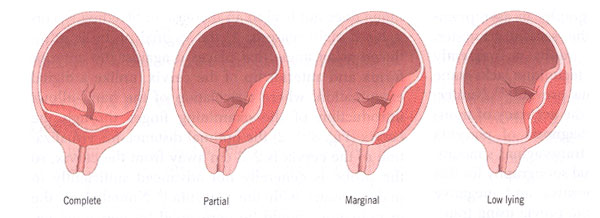Placenta previa is a complication of pregnancy that can occur when certain conditions are present in the pregnancy. With modern medicine and getting your regular check-ups, this condition can be diagnosed early on and the correct medical interventions can be made. The placenta grows as the embryo develops. It is the primary source of nourishment and protection for the growing baby. In placenta previa, the placenta grows over the cervix to completely or partially obscure the cervix. If left untreated, the birthing process can become complicated.

How to Know If the Bleeding Is Caused by Placenta Previa
Bleeding during pregnancy can be caused by several conditions. Placenta previa bleeding happens more often between weeks 34 and 38, the stretching of the uterus and the change in shape of the uterus begins to pull the placenta away from the uterine walls.
Usually placenta previa is picked up by the second trimester of pregnancy. This is when a scan is done at the doctor's checkup. If not picked up earlier during the pregnancy, it may be diagnosed in the third trimester when certain signs and symptoms present themselves, such as cramping and unusual position of the baby.
The diagnosis is typically made during a routine prenatal checkup using an ultrasound or after an episode of bleeding. The type ultrasound scan done can be abdominal or trans-vaginal where the scanner is placed into the vagina to view the cervix and vaginal canal. MRI (magnetic resonance imaging) can also be used to clearly define the site of the placenta.
Are You in Risk of Placenta Previa?
There are some factors that may predispose a woman to placenta previa, and thus being more likely to have placenta previa bleeding:
- If there are scars on the walls of the uterus, such as from a previous uterine surgery like a C-section or dilatation and curettage (D&C) procedure, the possibility of having placenta previa is higher. This also includes women with abnormally-shaped uteruses.
- A multiple pregnancy where the placenta is large to support more than one growing embryo. This can be twins or other multiple embryos.
- A pregnant woman over the age of 35 years. Reports show that older women are three times as likely to present with placenta previa than a younger woman.
- Smoking can cause a host of complications during pregnancy. Placenta previa is just one of them.
- Multiple pregnancies: a second or later pregnancy is at a far greater risk than the very first pregnancy.
- Some race groups are more susceptible to placenta previa, like Asians.
- A previous diagnosis of placenta previa
- A previous miscarriage
How to Relieve Placenta Previa Bleeding
There are a few types of placenta previa that can occur:
- Complete previa: the whole opening if the cervix is completely covered by the placenta. The baby is delivered via C-section and usually prematurely.
- Partial previa: a portion of the cervical opening is obscured. A vaginal delivery is still possible in this case.
- Marginal previa: the cervix is bordered by the placenta. Minor bleeding can occur during labour when a part of the placenta touches the cervix. Vaginal births can occur here.
- Low-lying placenta previa: the position of the placenta is at the edge of the cervix. If conditions are good, the birth can be a natural one.
Depending upon which type of placenta previa is present and the quantity of bleeding, the management of the condition will differ.
- No bleeding to minimal bleeding: bed rest will be prescribed where standing or sitting upright is minimized. Activities like exercise and intercourse may need to be avoided.
- Heavy bleeding: in this case, the patient should be on bed rest in the hospital because she may require blood transfusions and medication to prevent premature labour. The delivery will be done as soon as it is safe enough- usually after 36 weeks. The method of delivery will be a C-section. If the delivery is sooner than 36 weeks, the baby will be given special medication to speed up the lung development.
- Uncontrollable bleeding: A C-section will be performed as an emergency measure.
Other Mums' Experiences on Placenta Previa Bleeding
"When I was at 25 weeks of pregnancy, I was diagnosed with partial placenta previa. I was admitted to hospital and spent 3 days there. My doctor prescribed some light bed rest. At 28 weeks, I started bleeding again and spent one night and day in hospital being monitored. I am currently at 39 weeks with no further problems."
"At 18 weeks I was diagnosed with a complete placenta previa. My doctor advised me to be on bed rest. I experienced some spotting at 20 weeks of pregnancy and after that nothing more. I was monitored regularly and by the time I reached the 36th week, my placenta had moved away far enough from the cervix to be considered low-lying. I delivered my baby vaginally."
"I was diagnosed with complete placenta previa. At 19 weeks, I experienced heavy bleeding. I cannot follow the bed rest advice as I have another child who is a very active 2-year-old. At 28 weeks, my doctor said the placenta was moving away from the cervix and now it is only a partial placenta previa. My doctor thinks I have a very good chance at a natural birth rather than a C-section."
